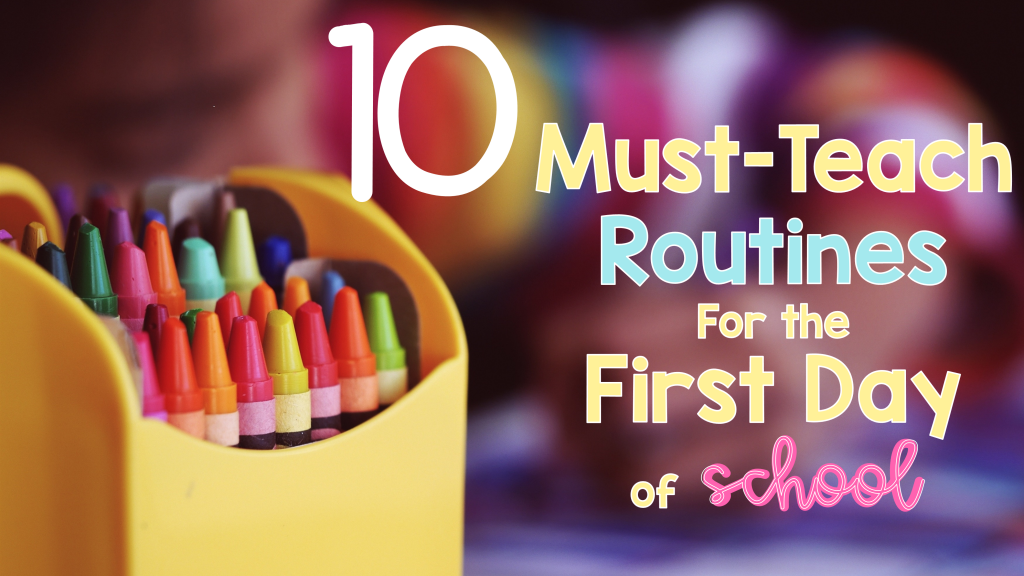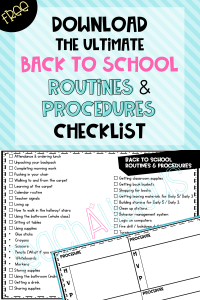
The first day of school can be very stressful for students but even more so for teachers. Setting up effective classroom routines and procedures are essential for a successful school year. After 10 (years) of teaching-first-day-of-school, here are my tried and true advices for 10 first day routines that you MUST teach this fall.
1. Community Building
Community building on day one is all about building the routine of taking turns, using social clues as we interact with each other, and noting student behaviors in a new environment.
This routine is very important but often gets overlooked on the first day.
It is important not only to explain how students are expected to interact with one another, but to also model what is acceptable behavior for students . In my classroom, I use restorative practices starting on day one. I explain that our Stella Luna bat is the “talking piece” and we take turns answering questions (What is your name and how do you feel?) then passing Stella Luna to the next person which ensures all students have a say and that their classmates are attentive to what each is saying. After everyone takes a turn, I narrate positive behavior that I noticed by saying things like, ” I noticed Morgan turn to track with eyes and ears when Juan had Stella Luna” (I NEVER praise a behavior, only narrate what I see).
2. MVP Routines
I use this routine acronym throughout the year for transitions and setting expectations for any and all activities. I write the letters on the board and explain in kid-friendly language what students should do.
M- (Movement) Will students be allowed to walk around the classroom? Sit at their tables? At the carpet? Open/Free choice seating?
V- (Voice) Will students be allowed to talk for group discussion? Work quietly on their own? Silent writing/reading?
P- (Participation) What behaviors will let you know that students are actively participating? Are students writing on their journals? Or using manipulatives to solve a problem? Perhaps reading a book? Maybe using a Chromebook? (The more explicit you are, the better the outcome).
3. How to read a book
Modeling students how to read pictures of a book in K and 1st on the first day of school is empowering for young readers. This routine is my favorite one for day 1. Just pick an interesting picture book and using think-aloud, share with students what you notice on the pictures and what you think is happening in the story. Encourage students to share what they see and what they think is happening.
This is NOT the time to teach a strategy, or to read the story. This is a routine to build reading confidence. Simple enjoy reading aloud (and you can read pictures more than once today!)
4. Building Stamina
Building routines for guided reading should start day 1. Since I read and implemented Daily 5 in my classroom, my teaching has taken on a whole new level! I follow their advice for this one. I set up baskets of books at each table and carpet. After I go over the expectations and model how to read-to-self, I let my kids work on their reading stamina reading pictures (or words). During this routine, I observe for those students that will need some extra support on building their reading stamina.
Once my kids reach their highest stamina (1 minute in some cases), I call students to the carpet and again narrate positive behaviors that I noticed from my students. We usually do a movement break or another activity after we practice this routine; but we go back to practicing read-to-self stamina once again later in the day.
5. Hallway walking
Prior to heading out the door, I talk to my kids about the importance of having self-control when walking down the hallway. Then, using my handy MVP chart, I set expectations for lining up and walking down the hall. I take my kids down the hallway and narrate positive behaviors again. As I narrate I make sure that my narration of positive behaviors aligns with the MVP chart we had discussed in class before.
6. Restroom use
I have 2 phases for this routine. For phase one, I may bring a small MVP board or just call out the letters as I set the expectations. Then students practice using the bathroom. I usually do this same procedure the first week of school, and release the responsibility once my students show they are ready.
Then for phase two (usually by the 2nd or 3rd week of school), I explain to students how to properly use the bathroom passes (blog post for phase two coming soon).
7. Using supplies
This routine is all about teaching responsibility and caring for our classroom. With my 1st graders, I tell them that Mr. Glue is a friend and we should treat him with kindness or he may go away. Mr. Glue likes to keep his hat (cap) and he hates being upside down. I model for students how to keep the glue stick up and only rub the paper we will glue on top. You bet kids will love to keep Mr. Glue happy and you will no longer have to find dry glue sticks (but if you do, make sure you take ALL Mr. Glues away for awhile).
I model for students how to use crayons, scissors, erasers and pencils. I model how to get a new pencil if they need a new one. Then I have students model for the class the right way, the wrong way, and then the right way again. Kids laugh when someone messes up and they want to do it right. Bringing joy and laughter into learning routines the first day is the key for students’ buy-in.
8. Clean up
Teaching students to clean up their work area is essential to instilling responsibility in students. You can do this by modeling how and narrating positive behaviors while students clean their space, organize their desks/tables, push in their chairs.
By this time of the day, students have seen the MVP at least 5 or more times. Encouraging students to participate in setting the MVP expectations for clean-up ensures that students take ownership of this task.
Remember, it is important to reflect on how students cleaned up as a whole class. You can ask students to check the MVP after they are done cleaning up. Did they follow the movement expectation, use the correct voice level, or show active participation? If so, how? If students did not meet all MVP expectations, remind students of MVP next time they are cleaning up and reflect on it again. Kids love to see how many check marks they can get. If they get them all, have them do a fun cheer, a dance or give each other high fives. Celebrating their small victories will go a long way!
9. Behavior management tool

I, usually, do not introduce any type of behavior management tool until the end of the first day. I personally love ClassDojo. First, I show my students how I will be awarding points throughout the day. Next, I show them the different behaviors and points they can earn. Then, I model how to award points individually and as a whole class. Finally, I have students practice giving themselves points. As the year goes by, students will be tracking their own behavior (more on this topic on another blog post in the near future).
10. Dismissal
Dismissal on the first day of school can be the most stressful part of the day. I use this chart to help me remember how each child dismisses. I teach my students to give me a high-five before leaving the classroom (if they are bus riders, car riders, or after school program participants) or the dismissal line (if they are walkers).
These 10 first day routines have helped me make first-day-of-school a less stressful and more enjoyable time both for my students as well as myself. The kids go home happy and I set strong routines and expectations for the year to come. Let me know what routines are a MUST for you by commenting below!


Leave a Reply